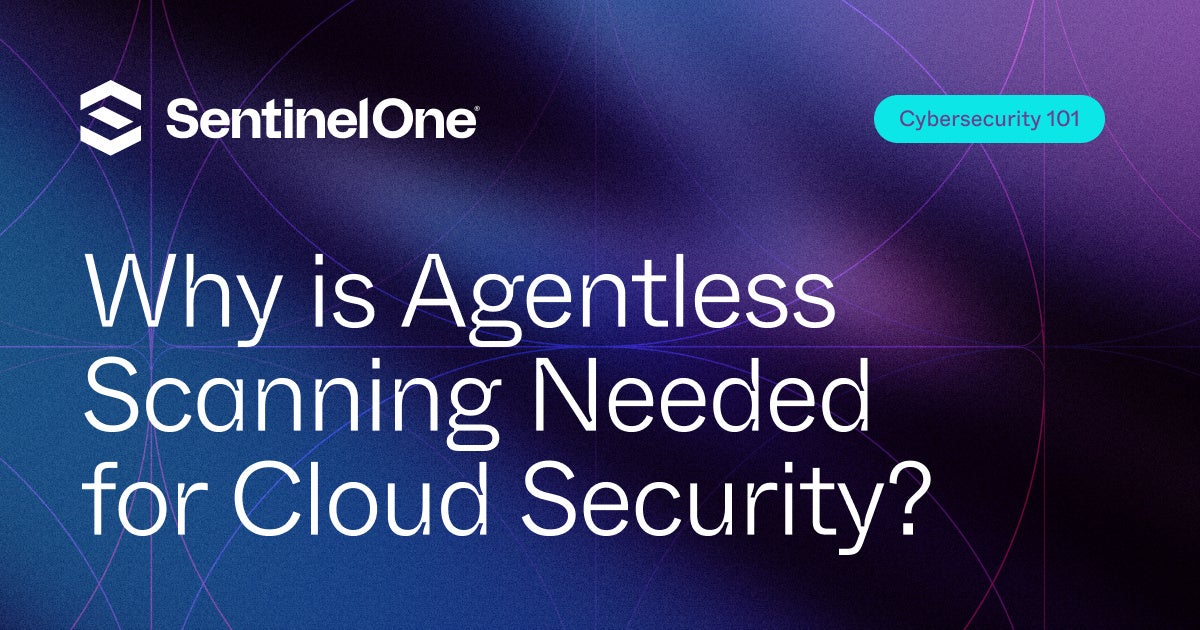With the rapid growth of cloud-native application development in various industries, cybersecurity has become a critical factor in the digital era. This begs the question, “How secure are cloud-running applications from cyber-attacks?” The increased cybersecurity attack surface faces a plethora of cyber threats, necessitating the need for cloud-based security solutions for cyber-attack incident prevention in the cloud.

Agentless scanning is one of the modern approaches to mitigating cloud-native security risks. It is a quick, easy-to-deploy security solution that helps monitor cloud assets without placing any code or agent inside the cloud infrastructure. Additionally, it examines cloud workloads for vulnerabilities and security risks without interfering with the instance’s execution. This way, agentless scanning helps your security team to have the flexibility and full coverage they need to secure their cloud environments.
Continue reading this post to learn about the importance of agentless scanning in cloud security.
What is Agentless Scanning?
Agentless scanning is the process of monitoring cloud workloads in order to gain visibility into vulnerability risks across your cloud workloads without the need for agents to be installed. An agent is a piece of software that is installed on the workload to perform security-related functions such as information gathering, scanning, and patch installation. All of these functions are accomplished with agentless scanning by utilizing a centralized API security solution that provides organizations with a complete inventory of external APIs as well as their security posture, allowing for easy vulnerability scanning. Consider agentless scanning to be a human spy in an invisible cloak: the spy monitors and watches every move you make, but there is no physical evidence to prove it. Or, even better, CCTV cameras for the cloud.
Agentless scanning is best suited for cloud-native workloads that require platform independence to function with any cloud provider. The goal of agentless scanning is to help security teams identify, prioritize, and correct cloud-related risks and incorrect configurations across their cloud environments.
How does Agentless Scanning work in cloud security?
The foundations of agentless scanning are push technology and a centralized design. It is necessary to collect data on system profile and posture in order for agentless scanning to find vulnerabilities across cloud workloads such as virtual machines, serverless, containers, appliances, and so on. This can be accomplished by utilizing the APIs or methods of the various cloud assets, which periodically push data to a centralized remote system. Security teams can continuously assess workloads using collected data to identify blind spots and vulnerability risks by utilizing cloud-native API deployments.
To begin their execution, the majority of agentless scanning solutions employ an agentless proxy that creates a secure network connection among cloud assets. The agentless proxy uses the native API endpoints and services of the target workload at the level of the cloud service provider’s account. This enables them to provide 100% visibility across all cloud assets, the ability to scan for anomalies within the cloud infrastructure, and performance degradation-free operation regardless of environment or physical location. Agentless scanning operates in a real-time environment, across a variety of cloud server platforms, and provides threat detection and system response across the entire cloud asset network.
Agentless scanning solutions are growing in popularity, especially as organizations increasingly use dynamic and multi-cloud native environments. This is as a result of the increased accuracy of security vulnerabilities and performance metrics offered by agentless scanning solutions for cloud security, which increases the momentum for proactive vulnerability identification and remediation.
Benefits of Agentless Scanning
Agentless scanning has proven to be a very efficient cloud security solution, especially because it utilizes Cloud API connections that help take in all the relevant data about workloads. With agentless scanning, users benefit from full-stack visibility in the cloud without agents, something that is not possible with on-prem environments.
Below are the benefits of agentless scanning, discussed in depth.
1. Agentless Scanning is Platform-Agnostic
When using agentless scanning to find and scan assets, there are no OS compatibility requirements or concerns. This enables it to scan routers, switches, and other network-based IoT (Internet of Things) devices without interfering with their execution.
2. Decreases management Costs
Agentless scanning systems are portable enough to be quickly and easily deployed on workloads. Thus, this is hugely beneficial for organizations managing hundreds of thousands of virtual machines as it reduces the management overheads.
3. Scalability
Scaling in agentless scanning from a single server to a big data center is simple. Typically, it makes use of scalable, lightweight protocols for significant contexts, which help in establishing network connections of the cloud assets for a comprehensive agentless scanning.
4. There is no negative impact on the environment.
Agentless scans capture a snapshot of the resources with each scan, so unlike an agent-based approach, no changes are made to the resources themselves. Because security teams will not need to perform resource maintenance, any changes to the agentless scanner will have no effect on the environment. The volume snapshot technique of agentless deep scanning ensures that there will be no impact on performance in an environment because the connectors are simply reading data via APIs and scanning out of band, rather than relying on the cloud environment’s CPU resources to execute.
5. Network Scanning Coverage
Agentless scanning provides complete visibility to the cloud network while defending numerous endpoints. This enables accurate vulnerability scanning of workloads, including all host assets, connected devices, active applications, and their dependencies. As a result, there are no blind spots in asset identification and scanning, which are automatically updated on a continuous basis.
Conclusion
With the growing adoption of multi-cloud and dynamic infrastructures, agentless scanning is one of the best cloud-native security solutions available today. It makes use of the power of APIs to improve visibility of the cloud estate and scan for vulnerabilities across cloud workloads without degrading performance.
